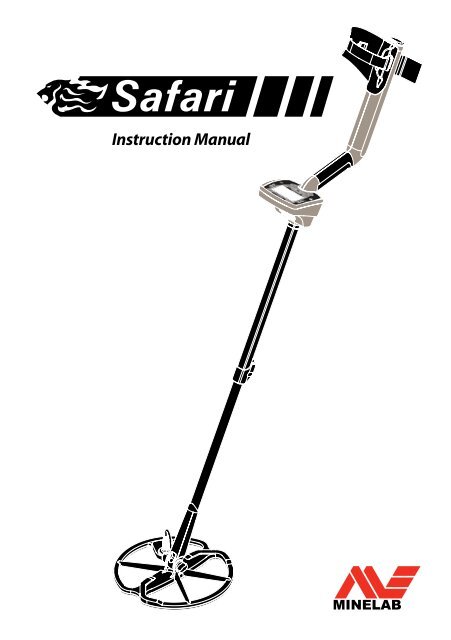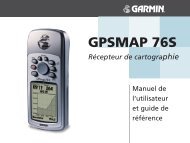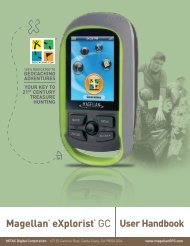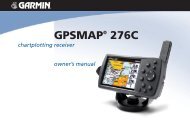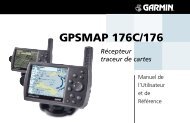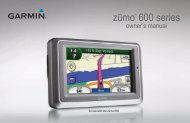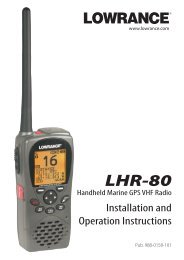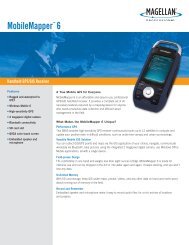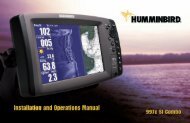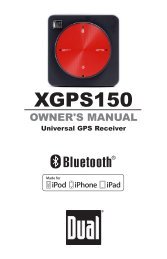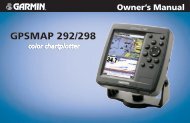Instruction Manual - Indian Nations Detectors
Instruction Manual - Indian Nations Detectors
Instruction Manual - Indian Nations Detectors
You also want an ePaper? Increase the reach of your titles
YUMPU automatically turns print PDFs into web optimized ePapers that Google loves.
<strong>Instruction</strong> <strong>Manual</strong>
Quick Start<br />
1 Turn on Safari by pressing the<br />
Power button.<br />
2 On initial start-up, your detector will default<br />
to the factory Coin Mode.<br />
3 To select a different factory preset Detect<br />
Mode, press and release the appropriate<br />
Mode button.<br />
4 The icon next to the corresponding<br />
preset Detect Mode, indicates that a<br />
factory preset Mode has been selected. The<br />
detector will apply the factory determined<br />
Discrimination Pattern and audio response<br />
for that Mode.<br />
5 Press the Noise Cancel button and wait<br />
the 20 seconds it takes to select the most<br />
stable channel.<br />
6 Once the Noise Cancel sequence is<br />
completed you can start detecting!<br />
Minelab is always interested in your opinions.<br />
If you have any questions or comments<br />
regarding the Safari or any other Minelab<br />
product, please feel free to contact us directly<br />
or via your local Authorised Minelab dealer.<br />
For further product information<br />
and detecting tips, refer to:<br />
www.Minelab.com
1<br />
Congratulations on purchasing<br />
your Minelab<br />
Thank you for purchasing the Minelab Safari<br />
metal detector.<br />
Metal detecting is a fascinating and<br />
rewarding activity enjoyed by people all over<br />
the world. By getting to know your Safari<br />
you can become one of the many successful<br />
detectorists who combine their passion<br />
for the outdoors with the excitement of<br />
discovering valuable coins, relics, gold and<br />
jewellery on a regular basis.<br />
Safari will locate valuable metal objects such<br />
as gold, coins, jewellery and other metallic<br />
items. The detector’s easy-to-use control<br />
panel enables anyone, from beginner to<br />
expert, to start detecting immediately after<br />
assembly.<br />
Minelab recommends you initially use Safari<br />
in one of the four selectable factory preset<br />
modes to become familiar with its operation.<br />
These Detect Modes have been optimised to<br />
provide you with settings suitable for most<br />
applications.<br />
Your Safari is designed to provide you with<br />
years of treasure hunting enjoyment. To<br />
ensure you get the most from your Safari, we<br />
recommend that you read this <strong>Instruction</strong><br />
<strong>Manual</strong> to help assemble, take care of and<br />
learn how to operate your new detector.<br />
Minelab wishes you every success with<br />
your Safari!
2 Contents<br />
Inside Front Cover<br />
3<br />
4<br />
5<br />
8<br />
10<br />
13<br />
14<br />
16<br />
18<br />
19<br />
21<br />
22<br />
22<br />
23<br />
23<br />
24<br />
25<br />
26<br />
26<br />
27<br />
27<br />
28<br />
28<br />
30<br />
30<br />
30<br />
32<br />
33<br />
34<br />
35<br />
36<br />
37<br />
38<br />
39<br />
40<br />
Quick Start<br />
How Metal <strong>Detectors</strong> Work<br />
The Technology of Safari<br />
Assembly<br />
Adjusting the Detector for Comfortable Detecting<br />
Battery Packs<br />
Turning the Detector On<br />
Introducing the Control Panel<br />
Introducing the Detect Screen<br />
Detecting Basics<br />
A Simple Detecting Exercise<br />
Detect Modes<br />
Coin Mode<br />
Coin & Jewellery Mode<br />
Relic Mode<br />
All Metal Mode<br />
Pinpoint<br />
Menu<br />
Sensitivity<br />
Target Volume<br />
Threshold<br />
Noise Cancel<br />
Contrast<br />
Trash Density<br />
Discrimination<br />
Discrimination (Accept/Reject) Scale<br />
To Modify the Discrimination Pattern<br />
To Create and Save a User Mode<br />
Technical Specifications<br />
Factory Presets<br />
User Information<br />
Recovering the Target<br />
Treasure Locations<br />
Detector Care and Safety<br />
Troubleshooting<br />
Warranty and Accessories<br />
Service and Repair Form
How Metal <strong>Detectors</strong> Work<br />
3<br />
Metal detectors create an electromagnetic<br />
(EM) field around the coil, which penetrates<br />
the ground. Because metal is conductive it<br />
causes a change in this field. The detector<br />
senses this change through the coil and<br />
sends a signal back to the control box,<br />
alerting the operator.<br />
Metal detectors can determine the size, shape<br />
and composition of metallic objects beneath<br />
the coil. Typically, the larger the object, the<br />
easier it is to detect.<br />
A metal detector’s EM operating frequencies<br />
are measured in kilohertz (kHz). Low<br />
frequency EM fields (e.g. 1.5kHz) penetrate<br />
the ground deeply, but sensitivity to smaller<br />
targets is low. High frequency EM fields (e.g.<br />
65kHz) have a shallower depth of penetration,<br />
but sensitivity to small targets is high.<br />
Safari’s multiple frequency operation provides<br />
the advantage of both; good depth and high<br />
sensitivity.<br />
Item Number: 4901 - 0070<br />
Revision: 1.1
4<br />
The Technology of Safari<br />
Full Band Spectrum (FBS)<br />
Most detectors on the market operate on a<br />
single or dual frequency, ranging from 1 to 70<br />
kilohertz (kHz).<br />
Although this technology has served the<br />
industry well for years, Minelab found that<br />
a frequency that worked well in one area<br />
would often offer only marginal performance<br />
when used in another location. Ground<br />
mineralisation, trash content and target<br />
size all had an impact on how effectively<br />
a detector transmitting a single frequency<br />
would operate.<br />
FBS technology combines Minelab’s<br />
multiple frequency BBS (Broad Band<br />
Spectrum) technology with a powerful new<br />
microprocessor to give:<br />
• Greater detecting depth<br />
• High sensitivity over a wide range of<br />
targets<br />
• Less interference from electromagnetic<br />
sources<br />
• More accurate identification of target<br />
characteristics<br />
The FBS circuit automatically transmits<br />
multiple frequencies simultaneously. This<br />
increased frequency range means that the<br />
signal received from the detector coil is<br />
analysed from a wide range of responses.<br />
This allows Safari to analyse more target<br />
information so that the target identification<br />
(ID) is more accurate.<br />
Discrimination (Disc.)<br />
Discrimination is the ability of a metal<br />
detector to identify your desired targets (e.g.<br />
coins and jewellery) and eliminate signals<br />
from undesirable material (e.g. nails).<br />
Safari can be programmed in a number<br />
of ways to discriminate against unwanted<br />
targets in different types of ground.<br />
Ground Compensation<br />
Safari uses a sophisticated approach for<br />
the elimination of ground mineralisation<br />
effects. It uses advanced digital filtering to<br />
eliminate the influence of ground signals. This<br />
is achieved automatically, allowing you to<br />
concentrate on detecting targets.<br />
Single Frequency<br />
FBS Comparison<br />
FBS Multiple Frequency<br />
Dual Frequency<br />
Minelab’s unique FBS technology means<br />
deep, sensitive, accurate detecting.
Assembly<br />
5<br />
Attaching the coil to the Lower Shaft:<br />
Note: Before attaching the coil to the Lower<br />
Shaft, remove the nut, bolt and washers<br />
from the coil.<br />
1 Plug the two rubber washers into the holes<br />
on either side of the Lower Shaft.<br />
2 Feed the coil cable up through the inside<br />
of the Lower Shaft, ensuring the coil cable<br />
appears out the top of the Lower Shaft.<br />
5 Insert the bolt through the Lower Shaft and<br />
the bracket on top of the coil.<br />
6 Fasten with the nut provided, taking<br />
care not to damage the thread of the<br />
nut by over-tightening. This will need to<br />
be loosened later to adjust the coil to a<br />
comfortable detecting angle.<br />
3 Place the coil on a flat surface.<br />
4 Slide the Lower Shaft into the bracket on<br />
top of the coil. Ensure that the open side of<br />
the Lower Shaft faces the ground.<br />
WARNING: The coil cable is directly<br />
wired into the coil and is not removable.<br />
Any attempt to remove this cable will<br />
void your warranty.
6<br />
Assembly<br />
Attaching the Lower Shaft to the<br />
Upper Shaft:<br />
1 Release the Upper Shaft camlock by pulling<br />
the lever away from the shaft.<br />
2 Feed the coil cable up through the inside<br />
of the Upper Shaft, ensuring the camlock<br />
side of the shaft is facing the ground.<br />
Connecting the Shaft Assembly to the<br />
Handle Assembly:<br />
1 Release the Control Box camlock by pulling<br />
the lever away from the Control Box.<br />
2 Align and push the coil cable connector<br />
into the socket underneath the Control Box,<br />
firmly tightening the retaining ring<br />
to secure.<br />
3 Slide the Upper Shaft over the Lower Shaft,<br />
so the coil cable appears out the top.<br />
3 Push the Handle Assembly onto the Upper<br />
Shaft, as far as it will go.<br />
4 Lock the Control Box camlock by pushing<br />
the lever flat onto the Control Box.
7<br />
Attaching the Armrest Strap:<br />
1 Clip both buckles onto the outer sides of<br />
the armrest.<br />
Disconnecting the coil:<br />
1 Reverse the steps in ‘Connecting the<br />
Shaft Assembly to the Handle Assembly’,<br />
‘Attaching the Lower Shaft to the Upper<br />
Shaft’ and ‘Attaching the coil to the<br />
Lower Shaft’.<br />
2 Pull the coil cable out from inside the<br />
lower shaft.<br />
Attaching the Headphones:<br />
1 Plug the headphone jack into the<br />
headphone socket, located in the<br />
rubber seal at the battery end of the<br />
Handle Assembly.<br />
The headphones may be plugged or<br />
unplugged at any time.<br />
WARNING: Do not attempt to<br />
completely remove the shaft assembly<br />
while the coil cable is still connected to<br />
the Control Box.
8 Adjusting the Detector for<br />
Comfortable Detecting<br />
For comfortable detecting it is important to<br />
take the time to adjust the detector correctly.<br />
Holding the Detector<br />
Thread your arm through the armrest and<br />
strap. Grasp the handle of the detector and<br />
rest your forearm in the armrest.<br />
The correct position of the armrest should<br />
allow you to comfortably grip the handle.<br />
Your elbow should sit just above the back of<br />
the armrest and the detector should feel like<br />
an extension of your forearm.<br />
Adjusting the Armrest Strap:<br />
1 Loosen the strap by tilting the top edge<br />
of the buckle out to release it from<br />
the armrest.<br />
2 Undo the Velcro and pull the buckle<br />
outwards (towards yourself ) to loosen<br />
the strap.<br />
3 Clip the buckle back into place and tighten<br />
the strap until your arm is secure whilst in<br />
the armrest. Re-attach the Velcro.<br />
Adjusting the Position of the Armrest:<br />
1 Use a screwdriver, or the edge of a coin,<br />
to loosen the screw in the centre of the<br />
armrest (turn counter-clockwise).<br />
2 While holding the detector, slide the<br />
armrest to sit just below your elbow.<br />
3 Remove your arm. Tighten screw (turn<br />
clockwise) to lock the armrest into position.
9<br />
Adjusting the Length of the Shafts<br />
A correct shaft length will allow you to<br />
swing the coil over the ground without<br />
uncomfortably stretching or stooping.<br />
If the coil is too far from your body it will be<br />
difficult to balance and manoeuvre<br />
while detecting.<br />
Adjusting the Angle of the Coil:<br />
1 Loosen the bolt that connects the Lower<br />
Shaft to the Coil. It should be loose<br />
enough to allow the Coil to be moved for<br />
adjustment, but tight enough that the Coil<br />
can hold its position.<br />
2 While holding the detector as if detecting,<br />
lightly press the Coil to the ground until it<br />
sits flat/parallel with the ground. The Coil<br />
should remain parallel when lifting to the<br />
sweep height, approximately 25mm (1”)<br />
above the ground.<br />
3 Tighten the bolt, but do not over-tighten it.<br />
Shaft is<br />
too short<br />
If the coil is too close to your body it may<br />
detect your digging tools or any other<br />
metal which you are carrying, causing<br />
confusing sounds.<br />
Adjust the lower shaft to the correct length,<br />
securing the camlock to hold it in place.<br />
A longer lower shaft is available for<br />
tall people (p. 39).<br />
Shaft is the<br />
correct length
10 Battery Packs<br />
Safari comes with a standard Alkaline battery<br />
pack. Eight high quality, fresh, 1.5V AA alkaline<br />
batteries will power the Safari for up to 14<br />
hours of constant use.<br />
Optional accessory NiMH battery packs are<br />
available as well (See Accessories p. 39). The<br />
NiMH 1600 mAh battery pack will power the<br />
detector for up to 12.5 hours of constant use<br />
and the NiMH 1800 mAh battery pack for 14<br />
hours.<br />
Unlike Nickel Cadmium batteries, the<br />
NiMH battery pack DOES NOT have to be<br />
discharged before recharging. Whenever<br />
the detector has been unused for a lengthy<br />
period, recharge the battery pack to ensure<br />
full performance. There is no limit to the time<br />
the battery pack can be left on charge.<br />
Removing the Battery Pack from the<br />
Battery Compartment:<br />
1 Ensure that the detector is turned off<br />
before removing the battery pack.<br />
2 Rest the detector on a flat surface.<br />
Disconnect the headphones.<br />
3 Lift the rubber seal of the battery<br />
compartment located at the end of the<br />
handle assembly.<br />
4 Raise the yellow tab to release the spring<br />
loaded battery pack.<br />
Note: Removal instructions apply to both types<br />
of battery packs.<br />
5 Remove the battery pack entirely from the<br />
battery compartment.<br />
WARNING: Do not attempt to<br />
disassemble the NiMH battery pack.<br />
If disposing of battery pack, do not<br />
incinerate. Contact your local authorities<br />
to enquire about disposal or recycling<br />
facilities.<br />
Inserting the Battery Pack into the<br />
Battery Compartment:<br />
1 Lift the rubber seal of the handle assembly.<br />
2 Slide the battery pack entirely into the<br />
handle assembly, until it clicks into place.<br />
3 Close the rubber seal, to close the battery<br />
compartment.
11<br />
Replacing ‘AA’ Batteries:<br />
1 Slide the lid of the battery pack in the<br />
direction of the arrow to open.<br />
2 Place eight high quality AA cell alkaline<br />
batteries into the battery pack, ensuring<br />
that the + and – terminals are aligned as<br />
indicated on the label.<br />
3 Slide the battery pack lid closed until it<br />
‘clicks’ into place.<br />
High quality alkaline batteries are<br />
recommended for optimum detection<br />
time. Rechargeable alkaline, NiMH or NiCad<br />
AA batteries may be used but must be<br />
removed and recharged separately. Check<br />
fitment of rechargeable batteries prior to<br />
purchase, as some do not comply with<br />
standard size requirements.<br />
– Please note the following:<br />
– Do not use rechargeable Lithium Ion<br />
batteries with your Safari. They may<br />
damage the detector and void your<br />
warranty. Rechargeable Lithium Ion<br />
batteries will give a combined voltage<br />
above 13V and therefore cannot be used<br />
with Safari.<br />
– Do not leave drained AA batteries in the<br />
detector as they can leak.<br />
– The optional rechargeable battery packs<br />
will not be damaged if left on the charger<br />
for more than 22 hours.<br />
– The battery chargers will not recharge<br />
rechargeable alkaline or NiCad AA batteries.<br />
– Using a non-Minelab charger with the<br />
battery pack may damage it and will void<br />
the product warranty.<br />
– Unlike Nickel Cadmium batteries, the NiMH<br />
battery pack DOES NOT need to be drained<br />
of all power before being recharged.<br />
– Do not charge the battery at temperatures<br />
above 45°C (113°F).<br />
– Do not charge the battery at temperatures<br />
below 0°C (32°F).<br />
– Do not leave the battery exposed to very<br />
hot conditions (e.g. on the dashboard or<br />
rear parcel shelf of your car) or very<br />
cold conditions.
12<br />
Battery Packs<br />
Charging the 1600/1800mAh NiMH<br />
Battery Packs (optional accessories)<br />
To charge your battery, only use the Minelab<br />
charger designed for your NiMH battery.<br />
Using other chargers may damage your<br />
battery and will void the product warranty.<br />
Recharging NiMH Battery Packs with the<br />
Mains Charger:<br />
1 Remove the battery pack.<br />
2 Insert the mains charger cable into the<br />
socket at the tapered end of the battery<br />
pack.<br />
3 Plug the mains charger into the wall socket<br />
and turn on the switch.<br />
4 Leave for 18 hours to fully recharge the<br />
1600mAh pack (22 hours for the 1800mAh<br />
pack). If the battery was not completely<br />
discharged, the charging time will be<br />
shorter. New batteries will reach their full<br />
capacity after several charge/discharge<br />
cycles.<br />
5 Once charged, disconnect the battery<br />
charger plug from the battery pack.<br />
Recharging NiMH Battery Pack with the<br />
Car Charger:<br />
1 Remove the battery pack.<br />
2 Insert the car charger plug into the<br />
accessories socket of your vehicle.<br />
3 Insert the car charger plug into the socket<br />
at the tapered end of the battery pack.<br />
A small light on the car charger illuminates<br />
indicating that the car charger is in<br />
operation.<br />
4 Leave for 18 hours to fully recharge the<br />
1600mAh pack (22 hours for the 1800mAh<br />
pack). If the battery was not completely<br />
discharged, the charging time will<br />
be shorter.<br />
5 Some vehicles may require the ignition to<br />
be switched on to ‘Accessories’ for power to<br />
be supplied to the charger.<br />
6 Charging the battery for longer than 18<br />
hours will not damage the NiMH battery<br />
pack. However, it may gradually discharge<br />
your car battery.<br />
Note: The car charger is provided with a<br />
fuse for short circuit protection. This can be<br />
accessed by unscrewing the tip of the<br />
charger plug.<br />
Note: It is normal for the tip of the<br />
rechargeable battery to get warm<br />
while charging.
Turning the Detector On<br />
13<br />
To Turn on Safari:<br />
Press and release the Power button to turn<br />
your detector on/off. On first time start-up,<br />
your detector will default to the Coin Mode<br />
and you can begin detecting.<br />
When you turn your detector on, the detector<br />
will start with the last setting used in your<br />
previous detecting session.<br />
Quick Start<br />
– Turn on Safari by pressing the<br />
Power button.<br />
– On initial start-up, your detector will default<br />
to the factory Coin Mode.<br />
– To select a different factory preset Detect<br />
Mode, press and release the appropriate<br />
Mode button.<br />
– The icon next to the corresponding<br />
preset Detect Mode, indicates that a<br />
factory preset Mode has been selected. The<br />
detector will apply the factory determined<br />
Discrimination Pattern and audio response<br />
for that Mode.<br />
– Press the Noise Cancel button and wait<br />
the 20 seconds it takes to select the most<br />
stable channel.<br />
– Once the Noise Cancel (p. 27) sequence is<br />
completed you can start detecting!<br />
Important: While performing a Noise<br />
Cancel it is important to keep the<br />
detector’s coil motionless, and also ensure<br />
that no metallic objects are moved in close<br />
proximity to the detector’s coil.
14 Introducing the Control Panel<br />
Coin<br />
Pressing activates the Coin Detect Mode (p. 22).<br />
Coin & Jewellery<br />
Pressing activates the Coin & Jewellery Detect Mode<br />
(p. 22).<br />
Power<br />
Pressing turns Safari On/Off.<br />
Holding for approx. five seconds resets the detector<br />
(p. 34) to the Factory Preset settings, prior to startup.<br />
Pinpoint<br />
Pressing turns Pinpoint On/Off . Pinpoint (p. 24)<br />
assists in locating the exact position of a target prior<br />
to recovery.<br />
Minus & Plus (–/+)<br />
Pressing in the Menu will step through the settings.<br />
Pressing within a Menu setting will adjust that setting<br />
(p. 25).<br />
Menu<br />
Used to access the Menu at any stage of detector<br />
operation. This allows access to various settings (p. 25).
15<br />
Relic<br />
Pressing activates the Relic Detect Mode (p. 23).<br />
All Metal<br />
Pressing activates the All Metal Detect Mode (p. 23).<br />
Noise Cancel<br />
Starts the scan for the quietest operating frequency.<br />
The scan takes approx. 20 seconds (p. 27).<br />
Accept/Reject<br />
Pressing in the Detect Screen accepts or rejects the<br />
detected target (p. 30).<br />
Legend Scale<br />
When a target is detected it is categorized based on the types of metal objects that typically produce a similar<br />
kind of signal. This is represented by the “flashing” icon in the Graphic Identification Bar. The Legend Scale is<br />
designed to be a useful guide to the “probable” composition of a target based on the detected signal. The<br />
accuracy of this representation is dependent on certain factors such as: ground type, target conductivity, the<br />
angle of the target in the ground, its depth, age and physical condition.<br />
Note: In some instances this can result in similar target objects appearing in different areas of the Graphic Identification<br />
Bar, which is not unusual. For example, the metal content of older pennies compared to new pennies can vary greatly<br />
and aluminium objects such as pull tabs (ring-pulls) may also display similar characteristics. The broken lines on the<br />
Legend Scale, between typical target types, represent the potential for overlap.<br />
As you gain experience with your Safari you will become more familiar with the audio and visual clues that the detector<br />
will provide.
16 Introducing the Detect Screen<br />
Depth Gauge<br />
Located in the centre of the Detection Screen is a<br />
vertical bar which predicts the likely depth of<br />
the target.<br />
On shallow targets the cursor is very close to the top<br />
and the bar becomes almost fully shaded, whereas for<br />
deep targets the cursor is quite close to the bottom<br />
and the bar is only partially filled.<br />
Target ID Number<br />
When a target is detected while searching, a number<br />
appears on the left side of the Detect Screen<br />
identifying the characteristics of the target.<br />
ID numbers ranging from –10 through to +40 are<br />
Safari’s numerical identification of the type of target<br />
that has been located. Different target types will bring<br />
up different numbers.<br />
Note: You can use these same ID numbers to make<br />
alterations to the Discrimination Pattern (p. 30) and they<br />
will also be useful for recognising common targets.<br />
Mode Indicator<br />
This icon, next to the corresponding preset<br />
Detect Mode, indicates that a factory preset Mode<br />
has been selected. The detector will apply the factory<br />
determined Discrimination Pattern and audio response<br />
for that Mode.<br />
The other icons that can appear here are:<br />
– This icon means that a Detect Mode has been<br />
modified but not yet saved.<br />
– This icon means that one of your User Modes<br />
has been selected.
17<br />
Battery Power Icon<br />
This shows the level of stored power in your battery.<br />
A fully charged battery shows the icon as fully shaded.<br />
As the power in the battery is used the shaded area<br />
depletes until a fully discharged battery is un-shaded.<br />
Target Icons<br />
Safari will also indicate the likely target type located,<br />
using a select number of generic icons. At times<br />
the Detect Screen may display two icons at once,<br />
indicating that the characteristics of the target located<br />
are similar to that of a number of targets.<br />
Note: Target icons only appear in the Coin and Coin &<br />
Jewellery Detect Modes.<br />
Graphic Identification Bar<br />
Located across the base of the screen is a horizontal<br />
bar graph which serves a number of purposes. It<br />
shows you the Discrimination Pattern that has been<br />
set, as well as:<br />
– Dark bars showing the areas of rejection. This means<br />
certain unwanted target types will be rejected (or<br />
ignored) by the detector.<br />
– Light bars showing areas of acceptance. This means<br />
the detector will recognise, and indicate to you,<br />
when certain desirable targets are found.<br />
– When a target is detected, a triangular cursor will<br />
flash three times above a cursor box, the location of<br />
which corresponds to the ID number shown in the<br />
Detect Screen.
18<br />
Detecting Basics<br />
Sweeping the Coil<br />
You will obtain the best performance<br />
when the coil is swept close and parallel<br />
to the ground at all times. This will increase<br />
detection depth and improve the response to<br />
small objects. Avoid excessive brushing of the<br />
coil on the ground. Though the coil assembly<br />
is rigid and durable, sudden jolts or bangs<br />
can cause random signals and inaccurate<br />
target IDs. Careful sweeping will ensure the<br />
detector performs to an optimum level<br />
at all times.<br />
Practise sweeping the coil over the ground<br />
in a side-to-side motion while slowly walking<br />
forward at the end of each sweep. Slightly<br />
overlap the previous sweep to ensure full<br />
ground coverage. An average sweep speed is<br />
four seconds from left to right to left.<br />
Targets<br />
Metal objects are referred to as targets.<br />
Targets are comprised of ferrous and<br />
nonferrous metals. Ferrous metals are those<br />
containing iron; such as steel, nails and some<br />
types of coins.<br />
Nonferrous metals are those which are not<br />
magnetic, such as gold, silver, copper, bronze<br />
and aluminium.<br />
You may wish to find a range of both ferrous<br />
and nonferrous targets.<br />
CAUTION: Incorrect coil sweeping can<br />
generate false signals or miss targets.<br />
Examples of common targets:<br />
Desired high ferrous target – war relic<br />
Undesired high ferrous target – iron nail<br />
Desired nonferrous target – gold coin<br />
Undesired nonferrous target – pull-tab
A Simple Detecting Exercise<br />
19<br />
Before attempting to recover real targets, it is<br />
important to understand how to interpret the<br />
audio and visual signals of the detector.<br />
Gather a collection of different metal objects,<br />
e.g. various coins, gold and silver jewellery, a<br />
nail, pull-tab, brass button and aluminium foil.<br />
Take the detector outdoors, away from known<br />
sources of EMI and metal objects.<br />
Lay objects in a line, sufficiently spaced apart<br />
to allow the coil to pass between them, as<br />
shown below.<br />
Detector Sounds<br />
Turn the detector On.<br />
The detector may produce False Signals<br />
(Noise) when not over the ground or with the<br />
coil held motionless. These may not be target<br />
signals, but surrounding electromagnetic<br />
interference (EMI). You can minimise these<br />
False Signals by performing a Noise Cancel<br />
(p. 27), or by reducing the Sensitivity (p. 26)<br />
of the detector. It is generally better to try<br />
to reduce False Signals by adjusting Noise<br />
Cancel before resorting to reducing<br />
the Sensitivity.<br />
The constant background ‘hum’ produced by<br />
the detector is called the Threshold (p. 27).<br />
Variations in the Threshold allow you to hear<br />
very small and deep targets. It is also used<br />
to help distinguish between desired and<br />
undesired targets.<br />
Sweep the coil across the targets one at<br />
a time. Observe the LCD and listen to the<br />
sounds of the detector as it passes over<br />
each object. Although the LCD will give you<br />
detailed information about the target, it is<br />
important to pay attention to the difference<br />
in audio response between each of<br />
the objects.<br />
Note: If you are getting signals from a<br />
visibly clear patch of ground, there could be<br />
buried metal objects. Try finding another<br />
area to practise.<br />
Nail Pull-Tab Foil Coins Jewellery
20 A Simple Detecting Exercise<br />
Detector Sounds (cont)<br />
The Audio Response is the sound produced<br />
by the detector when a target is detected<br />
and not ‘rejected’. When using Coin and Coin<br />
& Jewellery Mode, a highly conductive target<br />
(e.g. a large silver coin) will generally produce<br />
a high-pitched tone and a low conductive<br />
target (e.g. foil) will generally produce a lowpitched<br />
tone. Large targets or targets close to<br />
the ground surface emit louder signals.<br />
When a ‘rejected’ target is detected, the<br />
Threshold ‘blanks’ (becomes silent), indicating<br />
that a target is located underneath the coil,<br />
but has been rejected by the Discrimination<br />
Pattern (p. 30). Blanking is a useful way<br />
of distinguishing between desired and<br />
undesired targets.<br />
Note: As the coil passes over the nail, the<br />
Threshold ‘hum’ momentarily<br />
disappears (blanks).<br />
Large objects close to the coil may Overload<br />
the detectors electronics. When this happens,<br />
Safari displays an Overload message and<br />
emits an Overload sound until the coil is<br />
moved away from the source of the overload.<br />
Overloading is not harmful to the electronics<br />
of the detector.<br />
It is important to understand the sounds<br />
produced when you make a valid or invalid<br />
button press. You will usually encounter these<br />
sounds while adjusting settings via the Main<br />
Menu.<br />
Tip: When detecting do not wear steel-toed<br />
boots or shoes with metal eyelets. These can<br />
send conflicting signals to your detector.<br />
Target Response<br />
Threshold<br />
‘Blanking’ (No Sound)<br />
Threshold
Detect Modes<br />
21<br />
There are four factory preset Detect Modes<br />
and four Save Modes available for searching.<br />
Each Detect Mode is customized with the<br />
optimum settings, to allow you to find the<br />
types of objects described by the Detect<br />
Mode name.<br />
The four Detect Modes are:<br />
– Coin – Coin & Jewellery<br />
– Relic – All Metal<br />
In some locations, there may be a specific<br />
pattern to the type of targets found in the<br />
area. For example, an old house or building<br />
site may have areas where a certain junk is<br />
concentrated, or other areas where it is more<br />
likely that coins have been lost. On the beach,<br />
foil and modern coins are more plentiful in<br />
the dry sand, whereas less junk and more<br />
gold jewellery are located in the wet sand.<br />
Start – Up<br />
On initial start-up (or after Factory Preset),<br />
your detector will default to the factory Coin<br />
Detect Mode.<br />
To select a different factory preset Detect<br />
Mode, press and release the appropriate<br />
Mode button.<br />
The icon next to the corresponding preset<br />
Mode , indicates that a factory preset<br />
Mode has been selected. The detector will<br />
apply the factory determined Discrimination<br />
Pattern and audio response for that Mode.<br />
Note: You cannot change Detect Modes while in<br />
Pinpoint mode.<br />
Due to the different types of targets you may<br />
expect in certain areas, you will often prefer a<br />
different Discrimination Pattern for each area.<br />
With Safari you have the choice to search<br />
in one of the factory preset Discrimination<br />
Patterns, or you can create and save your<br />
own patterns to suit the different areas you<br />
commonly search.
22 Detect Modes<br />
Coin Mode<br />
This Mode has a Discrimination Pattern that<br />
is best for ignoring a variety of junk targets,<br />
while still being able to detect most coins.<br />
One of the features of Safari is its ability to<br />
vary the tone on the target signal. In Coin<br />
Mode the Audio tone will vary according<br />
to the level of conductivity of the detected<br />
metal. For example, highly conductive metals<br />
like silver, gold and brass will produce a high<br />
pitch tone. Lower conductive items like foil,<br />
nickel, and low carat jewellery will produce a<br />
lower pitched tone.<br />
The preset Discrimination reject settings for<br />
this Mode are –10 to +2 and +6 to +8.<br />
Use: This mode is best used in high trash<br />
areas such as modern parks, sporting<br />
grounds, playgrounds and busy beaches.<br />
It will ignore a large percentage of foil and<br />
ferrous trash.<br />
Note: Some modern coins are produced with<br />
nickel or steel cores and should be considered in<br />
certain regional applications. These coins may<br />
not be detected in Coin Mode.<br />
Coin & Jewellery Mode<br />
This mode has a slightly reduced level of<br />
rejection in its Discrimination Pattern to<br />
enable you to locate coins, as well as gold<br />
jewellery. It allows some coins with a high<br />
ferrous content or low carat jewellery that<br />
may have been discriminated in Coin Mode<br />
to be detected, however, aluminium foil will<br />
also be detected. The Audio tone will vary<br />
depending on the conductivity of the target<br />
in the same fashion as Coin Mode.<br />
The preset Discrimination reject settings for<br />
this mode are –10 to –1.<br />
Tip: Low tone = Low Conductivity content.<br />
High tone = High Conductivity content.<br />
Use: The most common use for this Mode is<br />
for those who are prepared to dig some foil<br />
and pull tabs to find all gold jewellery; ideal<br />
for beaches, old parks, abandoned house<br />
sites, camps, etc.
23<br />
Relic Mode<br />
The Relic Mode has an even lower level of<br />
rejection in its Discrimination Pattern as many<br />
rare and valuable relics can have very low<br />
conductivity, and/or ferrous content. The<br />
Audio tone in Relic Mode is different to Coin<br />
and Coin & Jewellery Detect Modes. It uses<br />
the ferrous (iron) content to determine the<br />
pitch of the Audio tone.<br />
Note: Depending on which Mode you select,<br />
a beep and icon will appear briefly which will<br />
indicate which mode the audio response is in.<br />
This is shown as:<br />
All Metal Mode<br />
All Metal Mode is similar to Relic Mode, the<br />
difference being that no Discrimination is<br />
used in All Metal Mode.<br />
All Metal Mode’s audio response also uses the<br />
object’s ferrous characteristics for producing<br />
the Audio tones, like in Relic Mode.<br />
Tip: This is the best Mode to use when a<br />
maximum target recovery rate is important, like<br />
in some competition hunts or when you are<br />
looking for any and all metals.<br />
or<br />
Conductive<br />
Audio Response<br />
Ferrous<br />
Audio Response<br />
In Relic Mode, a target with a high ferrous<br />
content will produce a low tone and a target<br />
with a low ferrous content will produce a<br />
high tone.<br />
The preset reject Discrimination settings for<br />
this Mode are –10 to –3. Because of this,<br />
beach hunters who specifically target gold<br />
jewellery may also prefer to use Relic Mode.<br />
In Relic Mode, the Detect Screen Target Icons<br />
are not shown. Operators using this mode<br />
are more likely to interpret signals using the<br />
Target ID Numbers and audio response only.
24 Pinpoint<br />
Pinpoint assists you in locating the exact<br />
position of a detected target.<br />
Normally, Safari is a ‘motion’ detector; it must<br />
be moving over a target in order to detect it.<br />
When Pinpoint is activated, Safari will operate<br />
as a non-motion detector; it will produce a<br />
constant audio response while the coil is held<br />
stationary over a target. Pinpoint instructs<br />
the detector to temporarily disengage<br />
Discrimination Patterns. Therefore, all targets<br />
will be detected if underneath the coil.<br />
3 Taking note of the response, reduce the<br />
span of each successive pass of the coil<br />
until you are confident of the location<br />
of the target. Make a mental note of the<br />
position, or mark a line on the soil with<br />
your shoe or a digging tool.<br />
4 Move to one side so that you can pass the<br />
coil over the target at right angles to your<br />
initial direction.<br />
5 Repeating the above steps in the new<br />
direction will give an exact location to dig.<br />
When Pinpoint is activated, the target icons<br />
on the detect screen will be replaced by a<br />
locator bar graph, as shown below.<br />
In Pinpoint, Safari will produce a clear ‘beep’<br />
as the search coil passes directly over the<br />
target. The locator bar graph in the Detect<br />
Screen will also fill out on the screen as the<br />
coil passes directly over the target.<br />
Pinpointing the Target:<br />
1 Once the approximate target location is<br />
known, move the coil to one side of that<br />
location and press Pinpoint.<br />
2 Sweep the coil slowly over the<br />
target location.<br />
Note: Keep the coil parallel to the ground<br />
while Pinpointing.<br />
Tips:<br />
– When in Pinpoint, Safari does not discriminate<br />
between metal targets.<br />
– Always press the Pinpoint button again<br />
when returning to search (do not search in<br />
Pinpoint mode)<br />
– After Pinpointing, and laying the detector<br />
down to dig the target, it is common for<br />
the detector to give an intermittent signal.<br />
Switching out of Pinpoint when digging, then<br />
returning to Pinpoint again if the location<br />
of the target needs to be confirmed can<br />
overcome this.<br />
– Do not press the Pinpoint button when<br />
directly over a target as this may cause a<br />
constant signal.
Menu<br />
25<br />
The Safari has the following user<br />
adjustable settings:<br />
– Sensitivity<br />
– Threshold<br />
– Noise Cancel<br />
– Target Volume<br />
– Contrast<br />
– Trash Density<br />
All the settings above are adjusted via the<br />
Menu screen by following these steps:<br />
1 Press the Menu button to access the<br />
Menu screen.<br />
4 Use the – or + arrow buttons to adjust the<br />
setting to the desired value.<br />
5 Press the Menu button again to apply the<br />
setting, and return to the Menu screen to<br />
select another control.<br />
Note: When you have finished making<br />
changes to the Menu settings [this may be<br />
just one or all six], you can press the Accept/<br />
Reject button, or any of the four Mode<br />
buttons, to return to the Detect Screen and<br />
start detecting.<br />
2 To adjust one of these settings, use the – or<br />
+ arrow buttons until the desired selection<br />
is highlighted. To avoid pressing the – or<br />
+ buttons numerous times, you can press<br />
and hold in the button and the selection<br />
will move smoothly, then release the<br />
button when you’ve reached your desired<br />
selection.<br />
3 Press the Menu button again, to activate<br />
the highlighted selection. This will take you<br />
to a screen specific to that setting.
26 Menu<br />
Sensitivity<br />
The Sensitivity control is adjustable to set the<br />
best level of Sensitivity for the environment<br />
being detected. The factory preset setting is<br />
in Auto, and this will self adjust to suit the<br />
conditions you are detecting in. You can also<br />
lock the Sensitivity to suit a particular area by<br />
manually selecting a level between 0 and 20.<br />
Target Volume<br />
The Target Volume control is used to adjust<br />
the maximum volume of the target signal —<br />
not Safari’s overall volume. The Target Volume<br />
range available is 0 to 20, and the preset level<br />
is 20.<br />
A manual Sensitivity setting can be<br />
used in areas with blanket/constant soil<br />
mineralisation, such as beaches or modern<br />
parks. However, Auto Sensitivity is the<br />
preferred setting when detecting areas with<br />
variable soil conditions, until you become<br />
experienced with your detector.<br />
Target Volume can be used to prevent signals<br />
from large and shallow items producing very<br />
loud signals that are uncomfortable to your<br />
ears. This should be adjusted to suit your<br />
individual hearing.<br />
Note: The Target Volume control sets the Target<br />
Volume only and does not affect the detector’s<br />
Sensitivity or power.<br />
Tip: If you prefer to search in <strong>Manual</strong> and some<br />
ground noise persists, reduce the Sensitivity level<br />
to the point where false signals cease.<br />
Tip: If your detector is unstable and producing<br />
erratic noises it is recommended to always<br />
perform a Noise Cancel prior to reducing the<br />
Sensitivity of the detector!
27<br />
Threshold<br />
The Threshold controls the audible level of<br />
sound during detecting, or the “background<br />
hum”. Most operators find that detecting<br />
with a very low but still audible Threshold is<br />
preferred. A lower level may mask responses<br />
to smaller targets and the higher levels will<br />
make targets difficult to hear. The level preset<br />
by Minelab is 12.<br />
Noise Cancel<br />
In many locations where you will be<br />
detecting there maybe electromagnetic<br />
interference (EMI) which can make your<br />
detector unstable. This instability will manifest<br />
as erratic false signals from the detector,<br />
which makes detecting actual targets very<br />
difficult. To eliminate the effects of EMI you<br />
will need to perform a Noise Cancel by either<br />
selecting it in the menu or by simply pressing<br />
the Noise Cancel button on the control panel<br />
(p. 15).<br />
The Threshold range is from 0 to 40.<br />
Tip: The use of headphones will normally allow<br />
the Threshold to be reduced.<br />
Whilst holding the detector still, press the<br />
Noise Cancel button on the control panel.<br />
Safari will automatically scan and select the<br />
quietest operating frequency and should run<br />
smoothly once complete. This process takes<br />
approximately 20 seconds.<br />
Important: While performing a Noise<br />
Cancel it is important to keep the<br />
detector’s coil motionless, and also ensure<br />
that no metallic objects are moved in close<br />
proximity to the detector’s coil.<br />
30cm<br />
(12”)<br />
As EMI can vary over time, you may need<br />
to repeat this process over the course of a<br />
detecting session.
28 Menu<br />
Contrast<br />
The contrast of the LCD can be adjusted<br />
using the Contrast control.<br />
Trash Density<br />
The Trash Density control will enable you to<br />
optimise your Safari for detecting in locations<br />
with differing amounts of trash content in<br />
the soil.<br />
By adjusting the Contrast, relative to the<br />
current light conditions, you may make the<br />
information on the LCD easier to see.<br />
High is the factory preset setting, suitable<br />
for most common locations where coins<br />
and relics are found, and also areas with<br />
variable ground mineralisation. The High<br />
setting detects targets at a faster rate, so in<br />
areas with a lot of trash, particularly if close<br />
together, the High setting is more likely to<br />
detect the presence of a “good” target in<br />
amongst a number of rejected or<br />
trash targets.<br />
In High setting, when rejecting certain<br />
targets using the Accept/Reject function,<br />
one or two more target ID segments/<br />
numbers may need to be rejected in order to<br />
fully ignore the target. However, if searching<br />
for a specific target, a much narrower “Accept”<br />
pattern is possible, allowing you to ignore<br />
a greater percentage of unwanted trash or<br />
other targets.<br />
High is the preferred setting when detecting<br />
in heavily mineralised or<br />
variable ground.
29<br />
In High setting, Safari’s signal response works<br />
faster to pick out good targets in between all<br />
the trash but requires a wider Discrimination<br />
Pattern to reject a specific target. This is easily<br />
demonstrated by attempting to use the<br />
Accept/Reject function in High setting:<br />
– Sweep the coil over a junk object that you<br />
would like to eliminate, and attempt to<br />
reject it by pressing Accept/Reject.<br />
– Now pass the coil over the target again and<br />
repeat the process<br />
– The Safari will continue to find different<br />
metals in the target and it will show<br />
different IDs.<br />
– It may require you to reject a number of<br />
ID numbers before a specific target is fully<br />
rejected.<br />
Low is a speciality setting which should<br />
only be used in very clean ground such<br />
as beaches or some inland locations such<br />
as open forests and large fields. In these<br />
locations, Low provides you with the most<br />
precise target ID and allows you to create<br />
a narrow Discrimination Pattern to reject<br />
troublesome trash targets.<br />
The Low Trash Density setting also has a<br />
slightly better depth capability in most soil<br />
conditions, but it is not recommended in<br />
areas where targets may be close together.<br />
The performance characteristics of the two<br />
modes is summarized in the table below:<br />
High setting can be used with a slightly faster<br />
sweep speed, so is suitable for use during<br />
competition hunts, or in areas where speed of<br />
ground coverage is important.<br />
Trash Density Performance Characteristics<br />
Setting<br />
Trash Density<br />
Accept/Reject<br />
Functionality<br />
Detection in average<br />
soils, and low trash sites<br />
Detection in mineralised<br />
soils, and high trash sites<br />
Low Very good Very good Average – may miss<br />
detection of nonferrous<br />
targets<br />
High Average Very good Good
30 Discrimination<br />
Discrimination (Accept/Reject) Scale<br />
When a target is detected, an ID number<br />
appears on the left hand side of the<br />
screen and a bar and cursor appear in the<br />
Discrimination scale along the bottom of the<br />
screen in the Graphic Identification Bar. In<br />
Coin and Coin & Jewellery Modes a Target<br />
Icon also appears on the right hand side of<br />
the screen.<br />
The location of the target cursor corresponds<br />
to the discrimination rating or ID number of<br />
the object.<br />
When an object is detected, the target cursor<br />
will momentarily flash.<br />
On the Graphic Identification Bar the black<br />
area represents rejected target IDs and the<br />
clear area represents accepted target IDs.<br />
Interpreting target responses<br />
To Modify the Discrimination Pattern:<br />
The Discrimination Pattern of a factory<br />
preset mode can be modified and saved as a<br />
personal setting, so that your own preferred<br />
Discrimination Pattern is ready for use any<br />
time you wish.<br />
The icon will be displayed on the screen<br />
to indicate that a mode has been temporarily<br />
modified.<br />
There are three methods of modifying the<br />
Discrimination Pattern.<br />
Method 1 –<br />
To reject a specific target/object:<br />
1 Wave the coil over the object. The detector<br />
will move the cursor to indicate the object’s<br />
position on the scale, and the target’s ID<br />
number will appear on the screen.<br />
2 Press the Accept/Reject button to reject the<br />
object’s ID.<br />
3 Wave the coil over the target and check<br />
that it is being rejected. If it still produces<br />
a response, reject its new ID by pressing<br />
Accept/Reject a second time.<br />
The Target ID Range has 51 numbers<br />
from –10 to +40.<br />
Ferrous (Iron) objects will have IDs<br />
in –10 to –1 range.<br />
Nonferrous (non-iron) objects will have IDs<br />
in the 0 to +40 range.<br />
Objects with higher Conductivity will have<br />
higher IDs.
31<br />
Method 2 –<br />
To reject a specific Target ID number:<br />
1 In the Detect screen use – and + buttons<br />
to select the ID you want to modify. The<br />
cursor and the Target ID numbers will<br />
indicate the selected ID.<br />
2 Press the Accept/Reject button to either<br />
accept or reject that ID. You will notice<br />
the band on the discrimination scale<br />
will become shaded if rejected or clear if<br />
accepted. The Accept/Reject button will<br />
toggle between accepting and rejecting<br />
targets.<br />
Method 3 –<br />
To accept or reject a large range of<br />
Target IDs:<br />
1 Start from either the first or last number of<br />
the ID band you wish to select.<br />
2 Push and hold both the Accept/Reject<br />
button, and the – or + button until the<br />
selected area is achieved. You will note that<br />
the cursor box on the Graphic Identification<br />
Bar will be shaded when the Accept/Reject<br />
button is in Reject mode and clear when in<br />
the Accept mode.<br />
Tip: The Accept/Reject button is very effective<br />
when in the Low Trash Density setting. The High<br />
setting enhances the detectors ability to pick<br />
out good targets in high concentrations of Iron,<br />
and as a result the Accept/Reject function is not<br />
as accurate. (See p. 28 for more information on<br />
Trash Density)<br />
Once the Discrimination Pattern has been<br />
modified, the icon will appear next to<br />
the Mode button to show that the Detect<br />
Mode has been modified. These changes to<br />
the Discrimination Pattern will be lost if you<br />
select a different Detect Mode. The modified<br />
Discrimination Pattern can be saved as a User<br />
Mode by following the steps in To Create and<br />
Save a User Mode (p. 32).
32<br />
Discrimination<br />
To Create and Save a User Mode:<br />
1 Select the factory preset Detect Mode you<br />
want to alter.<br />
2 Modify the Discrimination Pattern as per<br />
To modify the Discrimination Pattern<br />
on p. 30.<br />
3 Press and hold (approx. 3 seconds), the<br />
appropriate Mode button until the Saved<br />
message is displayed on the screen as<br />
shown below:<br />
Note: Any time a different Mode button is<br />
selected, a small sound (loudspeaker) icon is<br />
displayed next to the battery level icon. It will<br />
stay on for ten seconds and will show if the<br />
mode is using Conductive or Ferrous sounds. This<br />
is shown as:<br />
or<br />
Conductive<br />
Audio Response<br />
Ferrous<br />
Audio Response<br />
4 When the Mode is saved, the icon will<br />
appear next to the Mode button that was<br />
pressed. You can save your personal preset<br />
Mode in any of the four preset locations.<br />
Once a User Mode is saved, simply press<br />
the Mode button to revert to the factory<br />
preset Mode , or press it again to return<br />
to your personal saved Mode.<br />
This allows you to easily toggle between<br />
the two, to compare responses on<br />
various targets.
Technical Specifications<br />
33<br />
Detector<br />
Transmission Full Band Spectrum (FBS).<br />
Simultaneous Frequency Transmission ranging<br />
from 1.5–100kHz<br />
Coil 11” Double D (waterproof )<br />
Audio Output<br />
Liquid Crystal Display (LCD)<br />
Internal Speaker or Headphones<br />
64 x 128 pixels (40mm x 70mm)<br />
Length Collapsed: 1050mm (41”)<br />
Extended: 1370mm (54”)<br />
Detector Weight 1.65kg (3.63lbs) (excluding batteries and<br />
headphones)<br />
Coil Weight (Including Skidplate) 522g (1.15lbs) +/– 10g (0.02lbs)<br />
Operating Temperature Range<br />
Operating Humidity Range<br />
Storage Temperature Range<br />
0°C to 50°C (32°F to 122°F)<br />
Up to 90% Relative Humidity at 40°C (104°F)<br />
–30°C to 80°C (–22°F to 176°F)<br />
Battery (Accessory Item Only)<br />
Type<br />
Nickel Metal Hydride (NiMH)<br />
Output Voltage 9.6V<br />
Capacity<br />
Input (Charge)<br />
Charge Time<br />
Weight<br />
Operating Temperature<br />
Storage Temperature<br />
Battery Charge Temperature Range<br />
1600mAh or 1800mAh<br />
12V @ 100mA<br />
1600mAh = 18 hours, 1800mAh = 22 hours<br />
255g (0.56lbs)<br />
0 °C to 50 °C (32 °F to 122 °F)<br />
–30 °C to 80 °C (–22 °F to 176 °F)<br />
0 °C to 45 °C (32 °F to 113 °F)
34 Factory Presets<br />
Detect Modes<br />
All Settings<br />
Setting Title Range Factory Preset My Preferred<br />
Discrimination<br />
Menu Settings<br />
Detect Mode<br />
Coin, Coin & Jewellery,<br />
Relic or All Metal<br />
Coin Mode<br />
Coin –10 to +40 –10 to +2 and +6 to +8<br />
Coin & Jewellery –10 to +40 –10 to –1<br />
Relic –10 to +40 –10 to –3<br />
All Metal –10 to +40 Open<br />
Sensitivity Auto or 0–20 Auto<br />
Threshold 0–40 12<br />
Noise Cancel – Automatic<br />
Target Volume 0–20 20<br />
Contrast 1–20 10<br />
Trash Density Low or High High<br />
– Each factory preset Detect Mode has a slot for saving your own User Mode (p. 29).<br />
To start the detector in the ‘Factory Preset’<br />
mode, (recommended in your first few<br />
outings) press and hold the Power button<br />
(approximately five seconds) until the Factory<br />
Preset message is displayed on the screen.
Recovering the Target<br />
35<br />
A trowel, knife or small spade are good tools<br />
for recovering targets.<br />
Once a target has been located, clear the<br />
surface of loose material and check again for<br />
a signal. If there is no signal then the target<br />
is amongst the surface material. In this case,<br />
search the surface material until the target<br />
is located. If the target is still in the ground,<br />
Pinpoint its position.<br />
Check the hole for the target. If it is not in<br />
the hole, place the detector on the ground<br />
with the coil flat, pick up a handful of soil and<br />
pass it over the coil. Be sure not to wear rings,<br />
bracelets or a watch which will produce a<br />
signal. Repeat this procedure until the target<br />
is located.<br />
Using a sharp tool, cut a neat portion of grass<br />
or soil and place it on a plastic sheet. This<br />
prevents the material being scattered around<br />
and allows the hole to be refilled quickly.<br />
Dig carefully to avoid defacing or devaluing<br />
the object.<br />
Ensure that no other targets remain, then<br />
refill the hole. All soil and portions of grass on<br />
the plastic sheet should be returned to the<br />
hole as neatly as possible. Step lightly on the<br />
soil to compact it.<br />
Leaving holes, or a scarred area, may result<br />
in action being taken to prevent the use<br />
of metal detectors. Please ensure that you<br />
remove all rubbish. The aim is to leave the<br />
area of ground exactly as you found it.
36<br />
Treasure Locations<br />
A question most new detectorists ask is,<br />
“where do I find treasure”? There are actually<br />
lots of areas in which you can search. It is<br />
best if you research where people have been<br />
in the past, what type of objects they might<br />
have had with them, and hopefully lost. You<br />
can also go to areas people still use on a daily<br />
basis such as the beach or parks, and search<br />
for modern coins and jewellery.<br />
Here is a list of some of the more productive<br />
places to search:<br />
– Your own backyard<br />
– The beach<br />
– Showgrounds & racecourses<br />
– Picnic areas<br />
– Battlefields<br />
– Camping grounds<br />
– Swimming holes<br />
– Parks and playgrounds<br />
– Ghost towns & ancient town sites<br />
– Old homes & public buildings<br />
– Old gold mining sites<br />
– Sports grounds<br />
– School yards and ovals<br />
– Around jetties and piers<br />
– Drive-in theatres<br />
There is a chance of finding buried treasure,<br />
such as coins, relics and jewellery, anywhere<br />
that people have been in the past. In order<br />
to maximise your return, select sites that have<br />
the most potential.<br />
For example, a small park that is just used<br />
as a walkway between houses is likely to<br />
be littered with junk with very few valuable<br />
targets in it. Whereas a larger old park with<br />
picnic tables, playgrounds, etc. would have<br />
had thousands of people sitting around,<br />
playing sports, laying on blankets etc. and<br />
you can almost be certain that there will be<br />
some goodies waiting for your metal detector.<br />
Note: Be sure to obtain the land owners<br />
permission before searching on private property,<br />
and always check local regulations. Your local<br />
Minelab dealer may be able to assist.<br />
Always refill your holes. If you leave the<br />
ground exactly as you found it, you shouldn’t<br />
have any problem detecting the same area in<br />
the future.
Detector Care and Safety<br />
37<br />
Safari is a high-quality electronic instrument,<br />
finely engineered and packaged in a durable<br />
housing. Taking proper care of your detector<br />
is mostly common-sense.<br />
CAUTION – Please note the following:<br />
– Do not leave the battery pack in the Safari<br />
handle when the detector is not in use<br />
for extended periods. Damage caused<br />
by leaking batteries could be severe and<br />
would void the warranty through user<br />
negligence.<br />
– Do not leave the detector in excessive cold<br />
or heat for longer than necessary. Covering<br />
it when not in use will help protect it.<br />
Avoid leaving it in a closed car boot or<br />
in a car sitting in sunlight. A full-length<br />
detector carry bag is available to protect<br />
the detector when in transit.<br />
– The control box has been designed to resist<br />
moisture, but is not water-proof. Minelab<br />
advises protecting the control box in<br />
extreme conditions. The control box should<br />
not be dropped into water. A control box<br />
cover will give protection against dust, dirt<br />
and light rain.<br />
– Never allow the detector to come into<br />
contact with gasoline or other petroleumbased<br />
liquids.<br />
– Keep the detector clean and dry and avoid<br />
getting sand and grit into the shafts or<br />
fastenings (e.g. yoke bolt and camlocks). Do<br />
not use solvents to clean the detector. Use<br />
a damp cloth with mild soap detergent.<br />
– Ensure the coil cable is in good condition<br />
and not subject to undue stress.<br />
– Flat or faulty batteries cause many detector<br />
problems. Ensure that only quality alkaline<br />
batteries are used, and that they are<br />
replaced when you hear the warning signal<br />
through the headphones or speaker.<br />
– Do not dispose of the optional NiMH<br />
battery pack in fire (contact local authorities<br />
for disposal/recycling). Do not attempt to<br />
disassemble or short circuit the battery<br />
pack.<br />
– Take precautions when transporting or<br />
storing the detector. Although the detector<br />
is constructed from the highest quality<br />
materials and has undergone rigorous<br />
durability tests, the display screen could be<br />
prone to scratching or serious damage if<br />
not treated with due care.
38 Troubleshooting<br />
Detector does not start at all<br />
Detector starts, but it switches<br />
off by itself<br />
No sound<br />
Erratic noises<br />
No target response<br />
– Check the condition of the batteries and battery connections.<br />
– Ensure battery pack is fully inserted, and it has clicked into place.<br />
– If using alkaline batteries, check whether they have been loaded<br />
in the right polarity.<br />
– Check the condition of the batteries. If necessary, try starting with<br />
batteries known to be in good condition.<br />
– Detector may be too hot. Allow detector to cool down in a<br />
shaded area.<br />
– Try starting the detector with search coil disconnected. If the<br />
detector starts normally, check the state of the coil cable. If it is<br />
damaged, replace the coil. Otherwise return detector for repairs.<br />
– Unplug the headphones. If there is sound in the speaker but not<br />
in the headphones, check the headphones and their connection.<br />
– Check the Target Volume setting (a setting of 0 is silent).<br />
– If there is no sound in the speaker or the headphones but the<br />
detector appears to work normally otherwise, return the detector<br />
for repairs.<br />
– Press the Noise Cancel button.<br />
– Reduce the Sensitivity.<br />
– Change the orientation of the coil to the vertical plane and rotate<br />
to see if there is a position where the noise is loudest.<br />
If this is the case, it means that there is a source of interference<br />
nearby which must be avoided.<br />
– Check battery charge and battery connections.<br />
– Ensure coil connector is tightened firmly.<br />
– Check headphones and their connection.<br />
– Check for sand or grit between coil cover and coil.<br />
– Ensure the detector is turned On.<br />
– Check headphones and their connection.<br />
– Check coil connection.<br />
– Check discrimination level. No signal will be given if target is<br />
within black area of the Graphic Identification Bar.
Warranty and Accessories<br />
39<br />
There is a two-year parts and labour warranty<br />
for the electronic control box of Safari. The<br />
coil has a one year parts and labour warranty.<br />
Refer to the supplier or Minelab for service,<br />
either in or out of warranty. The Minelab<br />
warranty does not cover damage caused<br />
by accident, misuse, neglect, alteration,<br />
modifications, or unauthorised service.<br />
For specific details of the Minelab warranty,<br />
please refer to Safari’s ‘Product Warranty Card’.<br />
This warranty is not transferable, nor is it valid<br />
unless the enclosed warranty registration card<br />
is returned to Minelab or your Minelab dealer<br />
within 14 days of the original purchase.<br />
Repairs<br />
In the unfortunate circumstance that the<br />
detector needs to be returned to Minelab for<br />
service, please fill out the Minelab Service<br />
Repair Form (or a photocopy of the same)<br />
and enclose it with the detector.<br />
Please supply as much detail about the<br />
fault as possible. This will assist our service<br />
engineers to rectify the problem quickly<br />
and efficiently.<br />
8” FBS Coil<br />
12V Car Charger<br />
NiMH SlimPack<br />
Koss UR-30 Headphones<br />
Parts and Accessories available<br />
for Safari:<br />
– 8” FBS Coil<br />
– 8” FBS Coil Skidplate<br />
– 11” Coil Skidplate<br />
– Sealed 1800mAh Rechargeable<br />
NiMH SlimPack<br />
– Sealed 1600mAh Rechargeable<br />
NiMH SlimPack<br />
– 12V Car Charger<br />
– Koss UR-30 Headphones<br />
– Tall Man Lower Shaft 610mm (24”)<br />
– Control Box Cover<br />
– Detector Carry Bag<br />
– Minelab Tool & Trash Bag<br />
If you would like to purchase any<br />
accessories for your Safari or any other<br />
Minelab product, please feel free to contact<br />
us directly or via your local Authorised<br />
Minelab dealer.
40<br />
Service Repair Form<br />
Owners Name<br />
Address<br />
Telephone Day ( ) Home ( )<br />
Fax ( )<br />
Email<br />
Todays Date<br />
Detector / Model<br />
Serial Number<br />
Purchased From<br />
Purchase Date<br />
Faulty Part(s)<br />
Description of Fault<br />
Please explain how we can replicate the problem in order to fix your detector.<br />
cut out or photocopy
The World Leader in Metal Sensing Technology<br />
From our origins in 1985, Minelab have specialised in advanced electronic<br />
technologies. Our competitive advantage was created almost immediately with a<br />
highly competent and innovative Research and Development team, inspired by the<br />
genius of Mr Bruce Candy.<br />
This commitment to innovation has enabled us to successfully market feature<br />
packed Consumer coin and treasure detectors enjoyed by hobbyists worldwide<br />
as well as high quality gold detectors used by both professionals and amateurs.<br />
Minelab’s advanced technology is also incorporated in detection equipment<br />
designed for military and humanitarian de-mining projects throughout the world.<br />
Today Minelab has manufacturing, distribution and customer service operations<br />
in Australia, Europe and the United States, and is an ISO 9001 Quality Endorsed<br />
Company. ISO 9001 is a worldwide quality standard certification that ensures the<br />
highest level of product quality for our customers.<br />
© 2008 Minelab Electronics Pty Ltd<br />
This document contains proprietary<br />
information which is protected by<br />
copyright. Apart from any use as<br />
permitted under the Copyright Act<br />
1968, no part may be reproduced by<br />
any process without written permission<br />
from Minelab Electronics Pty Ltd, 118<br />
Hayward Avenue, Torrensville, SA 5031,<br />
Australia.<br />
WARNING. This document contains<br />
Minelab Electronics Pty Ltd rights,<br />
technical data or restricted rights<br />
data, or both. Patents and trademarks<br />
apply. Safari, Serious Detecting and<br />
Minelab are all trademarks of Minelab<br />
Electronics Pty Ltd.<br />
Working for a Cleaner,<br />
Greener Future<br />
For Consumers within the European<br />
Union: Do not dispose of this equipment<br />
in general household waste.<br />
The crossed wheeled bin symbol on this<br />
equipment indicates this unit should<br />
not be disposed of in general household<br />
waste, but recycled in compliance<br />
with local government regulations and<br />
environmental requirements.<br />
Please dispose of this equipment via a<br />
recycling service or centre, or by returning<br />
the unit to the respective Minelab outlet<br />
as appropriate for your unit. This will enable<br />
the equipment to be disposed of in an<br />
environmentally safe manner.<br />
Disposal of unwanted electronic<br />
equipment in land filled waste may<br />
contribute to adverse long term<br />
environmental effect due to the<br />
leaching of contaminating and toxic<br />
substances contained within some<br />
electronic equipment.<br />
This device complies with<br />
part 15 of the FCC rules<br />
Operation is subject to the following two<br />
conditions: (1) this device may not cause<br />
harmful interference, and (2) this device<br />
must accept any interference received,<br />
including interference that may cause<br />
undesired operation.<br />
Disclaimer:<br />
The Minelab metal detector discussed<br />
in this instruction manual has been<br />
expressly designed and manufactured as<br />
a quality hobbyist metal detector and is<br />
recommended for use in coin, treasure and<br />
general metal detection in nonhazardous<br />
environments. This metal detector has not<br />
been designed for use as a mine detector<br />
or as a live munitions detection tool.<br />
Please note:<br />
Since there may be a variety of options<br />
available for this detector, equipment<br />
may vary according to the Model or<br />
items ordered with your detector. Certain<br />
descriptions and illustrations may also<br />
differ (in this manual) from the exact Model<br />
that you purchased. In addition, Minelab<br />
reserves the right to respond to ongoing<br />
technical progress by introducing changes<br />
in design, equipment and technical<br />
features at any time.<br />
Item Number: 4901 - 0070<br />
Revision: 1.1
Minelab Electronics Pty Ltd<br />
PO Box 537, Torrensville Plaza<br />
Adelaide, South Australia, 5031<br />
Australia<br />
Tel: +61 (0) 8 8238 0888<br />
Fax: +61 (0) 8 8238 0890<br />
Email: minelab@minelab.com.au<br />
Minelab International Ltd<br />
Laragh, Bandon<br />
Co. Cork<br />
Ireland<br />
Tel: +353 (0)23 885 2101<br />
Fax: +353 (0)23 885 2106<br />
Email: minelab@minelab.ie<br />
Minelab USA Inc<br />
871 Grier Drive, Suite B1<br />
Las Vegas, Nevada, 89119<br />
USA<br />
Tel: +1 702 891 8809<br />
Fax: +1 702 891 8810<br />
Email: info@minelabusa.com


